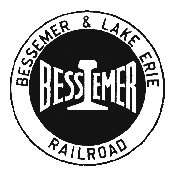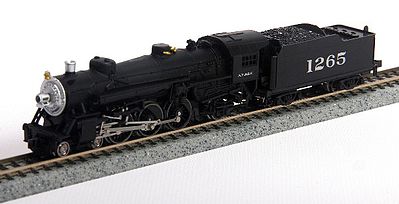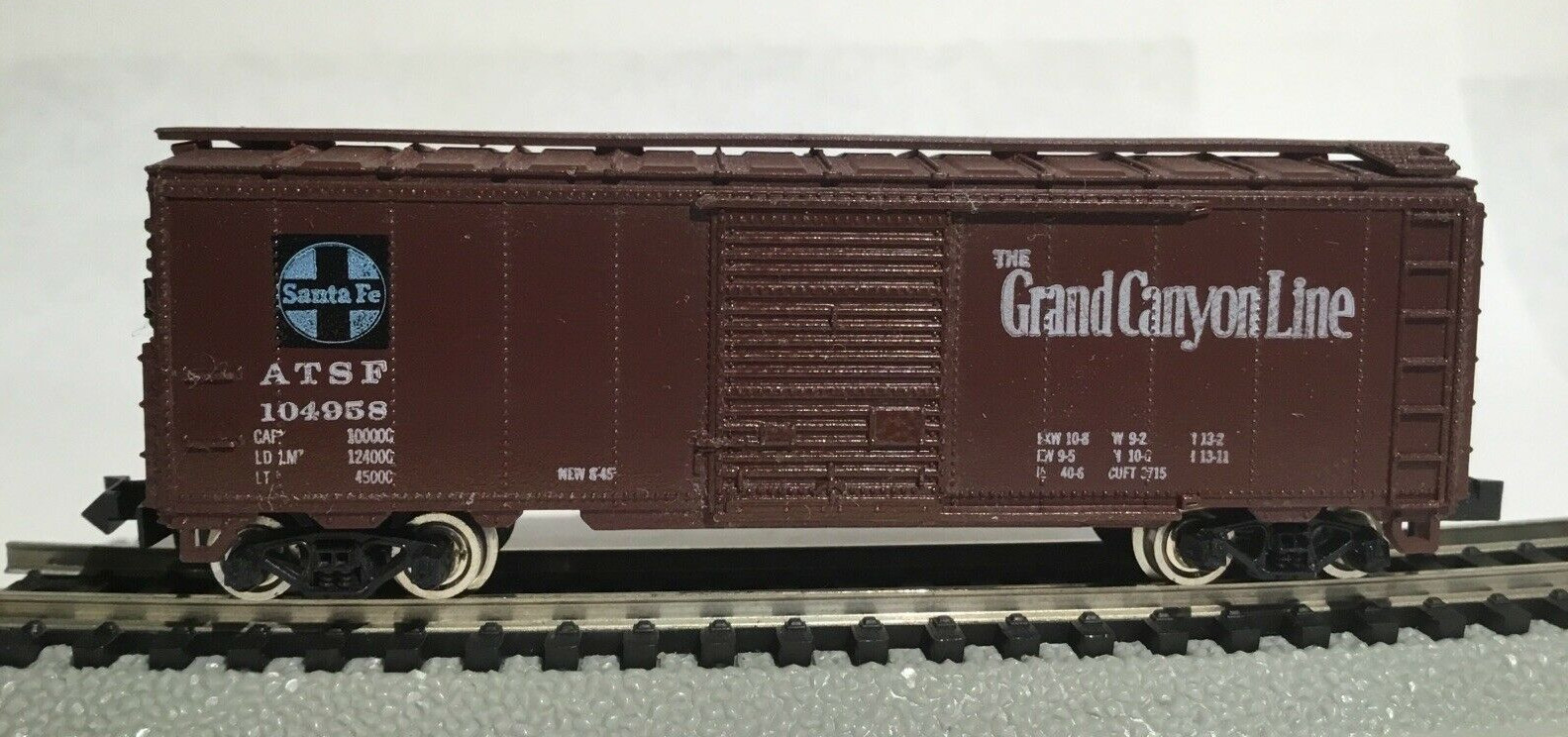Model Information: The series 38 Flatcar was first introduced in 1990. It is a similar design to the earlier 40 foot flat cars made by Rivarossi for Atlas in the 1960s and 1970s but is (quite obviously) 10 scale feet longer. The stakes come in a separate sprue and can be added as needed to appear appropriate with whatever load the user desires. The initial 1990 release included 13 different road names as well as an undecorated model, 3800.
Prototype History: A flatcar (US) (also flat car (US) or flat wagon (UIC)) is a piece of railroad (US) or railway (non-US) rolling stock that consists of an open, flat deck mounted on a pair of trucks (US) or bogies (UK), one at each end containing four or six wheels. Occasionally, flat cars designed to carry extra heavy or extra large loads are mounted on a pair (or rarely, more) of bogeys under each end . The deck of the car can be wood or steel, and the sides of the deck can include pockets for stakes or tie-down points to secure loads. Flatcars designed for carrying machinery have sliding chain assemblies recessed in the deck.
Flatcars are used for loads that are too large or cumbersome to load in enclosed cars such as boxcars. They are also often used to transport intermodal containers (shipping containers) or trailers as part of intermodal freight transport shipping.
From Wikipedia
Flatcars are used for loads that are too large or cumbersome to load in enclosed cars such as boxcars. They are also often used to transport intermodal containers (shipping containers) or trailers as part of intermodal freight transport shipping.
From Wikipedia
Road Name History: The Bessemer and Lake Erie Railroad (reporting mark BLE) is a class II railroad that operates in northwestern Pennsylvania and northeastern Ohio.
The railroad's main route runs from the Lake Erie port of Conneaut, Ohio to the Pittsburgh suburb of Penn Hills, Pennsylvania, a distance of 139 miles (224 km). The original rail ancestor of the B&LE, the Shenango and Allegheny Railroad, began operation in October 1869.
Rail operations were maintained continuously by various corporate descendants on the growing system that ultimately became the B&LE in 1900. In 2004 the B&LE came under the ownership of the Canadian National Railway as part of CN's larger purchase of holding company Great Lakes Transportation. As a subsidiary of CN the B&LE has been largely unchanged (though repainting of B&LE locomotives into CN paint with "BLE" sub-lettering began in April 2015) and still does business as the B&LE. Bessemer and Lake Erie's locomotives, especially the former Souther Pacific SD40T-3 "Tunnel Motors", have been scattered across the CN system lately; ironically, many are being used in the line that feeds most of B&LE's traffic, the former Duluth, Missabe, and Iron Range lines in Minnesota. The iron ore that originates on these lines is transloaded to ships at Twin Harbors, Minnesota, then sent by ship to Conneaut, Ohio, where it is again transloaded to B&LE trains. It is then taken down to steel mills in the Pittsburg area, mainly to the blast furnaces at US Steel's Edgar Thompson Plant in Braddock, Pennsylvania, part of the Mon Valley Works. As of summer 2015, most of the locomotives on the B&LE are former Illinois Central standard cab SD70's, although B&LE Tunnel Motor 905 and a few SD38's, still in B&LE orange, are being kept on the line. Also, a few Canadian National locomotives, especially SD60 5422, are assigned to the line.
The railroad's main route runs from the Lake Erie port of Conneaut, Ohio to the Pittsburgh suburb of Penn Hills, Pennsylvania, a distance of 139 miles (224 km). The original rail ancestor of the B&LE, the Shenango and Allegheny Railroad, began operation in October 1869.
Rail operations were maintained continuously by various corporate descendants on the growing system that ultimately became the B&LE in 1900. In 2004 the B&LE came under the ownership of the Canadian National Railway as part of CN's larger purchase of holding company Great Lakes Transportation. As a subsidiary of CN the B&LE has been largely unchanged (though repainting of B&LE locomotives into CN paint with "BLE" sub-lettering began in April 2015) and still does business as the B&LE. Bessemer and Lake Erie's locomotives, especially the former Souther Pacific SD40T-3 "Tunnel Motors", have been scattered across the CN system lately; ironically, many are being used in the line that feeds most of B&LE's traffic, the former Duluth, Missabe, and Iron Range lines in Minnesota. The iron ore that originates on these lines is transloaded to ships at Twin Harbors, Minnesota, then sent by ship to Conneaut, Ohio, where it is again transloaded to B&LE trains. It is then taken down to steel mills in the Pittsburg area, mainly to the blast furnaces at US Steel's Edgar Thompson Plant in Braddock, Pennsylvania, part of the Mon Valley Works. As of summer 2015, most of the locomotives on the B&LE are former Illinois Central standard cab SD70's, although B&LE Tunnel Motor 905 and a few SD38's, still in B&LE orange, are being kept on the line. Also, a few Canadian National locomotives, especially SD60 5422, are assigned to the line.
Brand/Importer Information: In 1924 Stephan Schaffan, Sr. founded the Atlas Tool Company in Newark, New Jersey. In 1933 his son, Stephan Schaffan, Jr., came to work for his father at the age of sixteen. Steve Jr. built model airplanes as a hobby and frequented a local hobby shop. Being an enterprising young man, he would often ask the owner if there was anything he could do to earn some extra spending money. Tired of listening to his requests, the hobby-store owner threw some model railroad track parts his way and said, "Here, see if you can improve on this".
In those days, railroad modelers had to assemble and build everything from scratch. Steve Jr. created a "switch kit" which sold so well, that the entire family worked on them in the basement at night, while doing business as usual in the machine shop during the day.
Subsequently, Steve Jr. engineered the stapling of rail to fiber track, along with inventing the first practical rail joiner and pre-assembled turnouts and flexible track. All of these products, and more, helped to popularize model railroading and assisted in the creation of a mass-market hobby. The budding entrepreneur quickly outgrew the limitations of a basement and small garage operation. Realizing they could actually make a living selling track and related products, Steve and his father had the first factory built in Hillside, New Jersey at 413 Florence Avenue in 1947. On September 30, 1949, the Atlas Tool Company was officially incorporated as a New Jersey company.
In 1985, Steve was honored posthumously for his inventions by the Model Railroad Industry Association and was inducted into the Model Railroad Industry Hall of Fame in Baltimore, Maryland. In addition, Steve was nominated and entered into the National Model Railroad Association Pioneers of Model Railroading in 1995.
In the early 1990s, the Atlas Tool Company changed its name to Atlas Model Railroad Company, Inc.
In those days, railroad modelers had to assemble and build everything from scratch. Steve Jr. created a "switch kit" which sold so well, that the entire family worked on them in the basement at night, while doing business as usual in the machine shop during the day.
Subsequently, Steve Jr. engineered the stapling of rail to fiber track, along with inventing the first practical rail joiner and pre-assembled turnouts and flexible track. All of these products, and more, helped to popularize model railroading and assisted in the creation of a mass-market hobby. The budding entrepreneur quickly outgrew the limitations of a basement and small garage operation. Realizing they could actually make a living selling track and related products, Steve and his father had the first factory built in Hillside, New Jersey at 413 Florence Avenue in 1947. On September 30, 1949, the Atlas Tool Company was officially incorporated as a New Jersey company.
In 1985, Steve was honored posthumously for his inventions by the Model Railroad Industry Association and was inducted into the Model Railroad Industry Hall of Fame in Baltimore, Maryland. In addition, Steve was nominated and entered into the National Model Railroad Association Pioneers of Model Railroading in 1995.
In the early 1990s, the Atlas Tool Company changed its name to Atlas Model Railroad Company, Inc.
Item created by: George on 2017-03-02 07:18:07. Last edited by CNW400 on 2020-06-24 09:51:22
If you see errors or missing data in this entry, please feel free to log in and edit it. Anyone with a Gmail account can log in instantly.
If you see errors or missing data in this entry, please feel free to log in and edit it. Anyone with a Gmail account can log in instantly.











